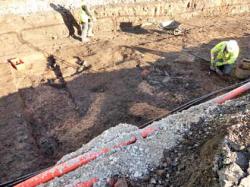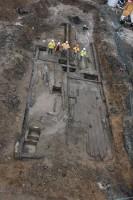INSTITUT SUPERIEUR D'ANTHROPOLOGIE
INSTITUTE OF ANTHROPOLOGY
ONLINE COURSES / COURS A DISTANCE
WINTER TERM : JANUARY 2016
REGISTER NOW
ROYAUME UNI –  Chester - A pair of beam slots from a Roman building have been found by archaeologists at a Chester car park . “They would have formed the building’s foundations,” says Councillor Brian Clarke, of Cheshire West and Chester Council. “Initial dating evidence suggests that the slots were erected some time during the late 1st or early 2nd century AD.
Chester - A pair of beam slots from a Roman building have been found by archaeologists at a Chester car park . “They would have formed the building’s foundations,” says Councillor Brian Clarke, of Cheshire West and Chester Council. “Initial dating evidence suggests that the slots were erected some time during the late 1st or early 2nd century AD.
http://www.culture24.org.uk/history-and-heritage/archaeology/art542327-chester-bus-interchange-archaeology-roman-timber
CHINE - Beiyuan - More than 300 items used by prehistoric people in their daily life 4,000 years ago were unearthed in northwest China's Ningxia Hui Autonomous Region. Wang Xiaoyang, head of the archaeological team, said on Monday that the pieces were found in the Beiyuan relic site, where the excavation area covers 800 square meters. The pieces include clay pots, basins, cups and knives, stone axes and chisels, as well as bone awls and needles. Archaeologists also found clamshells which they believed were used for decoration. The Beiyuan relic site, covering 25,000 square meters, was first excavated in 2013. This year about 40 people, led by the Ningxia regional archaeological institute, conducted a second excavation to learn more about Neolithic culture and development in the region. Experts searched 11 houses - one cave dwelling and ten kivas - 151 pits, three kilns and a tomb. The kivas were square in shape, with a round cooking range at the center and painted white with lime.
http://news.xinhuanet.com/english/2015-11/30/c_134869846.htm?
ISRAEL – Carmel - The Carmel forest fire, which took place five years ago this week, denuded thousands of dunams of land, besides taking 44 lives. But within the tragedy, there was one consolation – the discovery of an ancient farming community that dates back to the Second Temple era. Workers from the Jewish National Fund have since then worked on restoring the forest, with the initial work requiring clearing the land of debris to make way for new plantings. As they have been clearing parts of the forest, workers have discovered numerous treasures that were hidden among the trees – statues, coins, elaborate clay vessels, and other items. Among the most impressive things found was a set of well-preserved agricultural terraces, which archaeologists estimate dates back some 2,000 years. The terraces had actually been photographed in the past in an aerial photo taken in 1944, but had been forgotten as the forest grew around them.
http://www.israelnationalnews.com/News/News.aspx/204138?#.Vlx503YveM8
USA –  Alexandria - In 1749, when the Town of Alexandria was founded, the southwestern half of the property at 220 South Union Street was on top of a bluff overlooking a cove of the Potomac River. The filling of the cove (called “banking out”) in the late 18th century created the remaining land that became the northeastern half of the property. By 1755, Duke Street was cut through the bluff and extended down to the water. The Alexandria Trustees called upon John Carlyle to erect a public warehouse on the north side of Duke Street, on what would become 220 South Union Street. During the final days of September, 2015, hints of an exciting discovery began to emerge during construction of the new Indigo Hotel. Archaeologists from Thunderbird Archaeology were monitoring the excavation for the hotel garage, when large timbers were unearthed at the edge of Duke Street. Construction work ceased in the area to allow for a substantial archaeological investigation, which was completed in early November, revealing the remains of the public warehouse!!
Alexandria - In 1749, when the Town of Alexandria was founded, the southwestern half of the property at 220 South Union Street was on top of a bluff overlooking a cove of the Potomac River. The filling of the cove (called “banking out”) in the late 18th century created the remaining land that became the northeastern half of the property. By 1755, Duke Street was cut through the bluff and extended down to the water. The Alexandria Trustees called upon John Carlyle to erect a public warehouse on the north side of Duke Street, on what would become 220 South Union Street. During the final days of September, 2015, hints of an exciting discovery began to emerge during construction of the new Indigo Hotel. Archaeologists from Thunderbird Archaeology were monitoring the excavation for the hotel garage, when large timbers were unearthed at the edge of Duke Street. Construction work ceased in the area to allow for a substantial archaeological investigation, which was completed in early November, revealing the remains of the public warehouse!!
https://www.alexandrianews.org/archaeologists-discover-1755-warehouse-220-south-union-street/